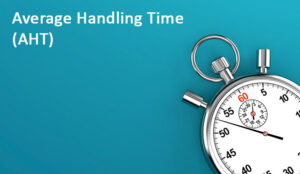Filipa Silva at Talkdesk explains how average talk time allows you to dig deeper into your contact centre’s interactions and customer experience.
Average talk time (ATT) has a very straightforward meaning: the amount of time an agent spends talking with customers. It must not be confused with average handle time (AHT), which corresponds to the total time spent by an agent completing a call (including talk time, hold, and wrap-up time).
AHT and ATT serve different purposes. While the first comprises the whole interaction, the ATT only considers the time spent talking to the customer. Being part of AHT, ATT gives you important information on the customer experience.
Overall, ATT alone doesn’t say much when analyzed alone. It’s the ATT percentage, as part of AHT, that you should focus on—ideally, most of AHT should be spent talking, not on caller waiting or administrative work.
What Does Average Talk Time Mean for Your Contact Centre?
Having a higher or lower ATT is not necessarily a good or a bad thing. You may want to scrutinize this metric regarding its impacts on AHT and customer-facing metrics, such as customer satisfaction (CSAT), net promoter score (NPS), or customer effort score (CES).
But if you look at ATT taking into account the AHT, you can get some relevant insights on what measures you need to take.
High AHT and low ATT, for example, could indicate inadequate staff training or inadequate call routing, meaning that the customers are often transferred more than once before having their queries resolved.
Low AHT and low ATT could indicate that calls are being handled incorrectly due to cost-driven pressures, that staff is undertrained, and that the systems are slow and after-call procedures are too complex.
On the other hand, high AHT and low ATT could mean that your agents are effectively trained on CX and call control, but the systems are limited, and the call routing is not effective.
Optimize Your Contact Centre Average Talk Time in Three Steps.
Decreasing AHT reduces contact centres’ cost per contact, allowing you to handle more calls with the same number of agents. The dilemma is balancing productivity and efficiency while ensuring agents remain focused on providing quality over speed when serving clients.
If you already put in place initiatives to drive AHT and call wrap time reduction, but you still need to further drive down AHT, then decreasing ATT should be the last resort. That being said, balancing ATT and CX is quite challenging, but there are three steps you can take without hurting your customer experience.
Step 1: Drive Training Improvement Insights by Listening to Calls.
By analyzing all conversations and comparing which ones have higher talk times and the most frequent issues that arise, you can drive essential insights to improve ATT.
An AI-powered speech analytics tool will help you showcase what customers are saying on every call, focusing on identifying conversation time that doesn’t add value and insights into potential customer journey pain points.
With these findings, you will be able to adequately guide agents through interactions and identify gaps in agents’ expertise, allowing you to better tailor training, coaching, and best practices.
Step 2: Leverage Faster Responses With Intelligent Call Routing.
Another way to improve ATT is to shift from the traditional queue to a skill-based or historical-based routing approach. Instead of delivering a call to the agent available at the moment that may not be suitable to resolve a specific issue, a skill-based routing will ensure the call is delivered to the best-skilled available agent.
If it’s a repeated call, historical-based routing will guarantee the same agent answers the caller, providing a better experience for the customer.
Both options promote a reduction in ATT by diminishing the need for transfers while improving first call resolution (FCR) and effectively reducing time spent on exploratory questions when delivered to an agent who had already contacted the customer.
Step 3: Simplify Agent Effort With Agent Assistance Technology.
Agents will be as fast as their knowledge allows them to. When not proficient in product features or specific issues, they rely on knowledge bases to guide their answers. However, all this information is frequently scattered on different platforms and not correctly adapted for in-call research.
An AI-powered agent assistant presents important customer information as soon as an agent picks up the call, making it easier to access systems and information, removing the need to look up data in multiple systems. It can also identify interaction warning signs and suggest escalation to protect both the customer and the agent experience.
Not only will you lower the ATT by eliminating search and browsing tasks, but you will also improve CX scores with more accurate and timely resolutions.
Benchmark Average Talk Time and Other Contact Centre Metrics.
ATT is an interesting metric to look at if you’re trying to identify CX gaps in your contact centre. However, as with any other metric, the goal shouldn’t be having the highest or the lowest ATT but rather understanding what it means to the customer experience.
It also might be helpful to compare your AHT and ATT against the competitors. It allows you to see where you stand against your peers and compare key metrics to recognize trends, fix pitfalls, and uncover opportunities to improve customer experience.
This blog post has been re-published by kind permission of Talkdesk – View the Original Article
For more information about Talkdesk - visit the Talkdesk Website
Call Centre Helper is not responsible for the content of these guest blog posts. The opinions expressed in this article are those of the author, and do not necessarily reflect those of Call Centre Helper.
Author: Talkdesk
Published On: 2nd Sep 2021 - Last modified: 7th Sep 2021
Read more about - Guest Blogs, Talkdesk






 Talkdesk is a global customer experience leader for customer-obsessed companies. Our contact center solution provides a better way for businesses and customers to engage with one another.
Talkdesk is a global customer experience leader for customer-obsessed companies. Our contact center solution provides a better way for businesses and customers to engage with one another. 












